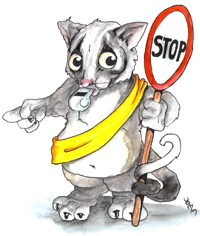 The following was obtained from a recent CSIRO newsletter Science by Email 27 June 2008 available free by subscription. See current issue here.
The following was obtained from a recent CSIRO newsletter Science by Email 27 June 2008 available free by subscription. See current issue here.
Seeing our native fauna lying injured - or dead - on the side of our roads is an all too common sight. It is an unfortunate reminder that the wilderness surrounding our cities is often little more than islands of habitat, making it risky for animals to move about.
In the past, a solution has been to erect a series of nets spanning the width of the highways - a lofty pedestrian crossing for possums. While there is some evidence that animals will use these walkways, only recently has this been studied in detail.
Ecologist Rodney van der Ree, from the Australian Research Centre for Urban Ecology, has completed the first study investigating the behaviour of animals in a habitat prior to a bridge being constructed. "We've been able to measure the extent of the problem before the bridge went up," Rodney says.
Using radio tagging, a range of marsupials - including several types of possum - were tracked for six months near the Hume Highway in Victoria. Their movements across the highway were recorded.
The tiny squirrel glider was the only animal studied capable of gliding between trees. It was found that it only crossed the road where large trees were grown on the highway's median strip. Other animals, such as brushtail possums, simply did not cross at all.
Reduced movement in a habitat can destroy entire populations of native species. Without the ability to relocate, groups of fauna are threatened by diseases that can spread rapidly. For threatened species, such as the sugar glider, this could make a significant impact on their numbers.
While the study is not yet complete, early results indicate that many animals are making use of the rope bridges. For example, some ringtail possums have been recorded crossing the walkways up to fifty times over six months. Others, such as brushtail possums and sugar gliders, have been seen making partial crossings. A number of other animals such as magpies, spiders and geckos have also been spotted on the bridges.
This information will be used to make decisions concerning where future bridges will be built. As more roads are built and more native bushland is affected, knowing how this will impact on our wildlife is becoming increasingly important.
Why did the possum cross the highway?
Because it can do so safely - at least that is what an Australian study into the impact of wildlife rope bridges shows.
He says early results show the animals have acclimatised to the bridge.
Since June last year they have recorded more than 50 crossings of ringtail possums and almost as many partial crossings, seven partial crossings of brushtail possums and four partial crossings by squirrel gliders.
"These early findings are impressive as they show that native animals have acclimatised to the 70 metre rope bridge and are using it to cross the highway to find food, shelter and mates," says van der Ree.
He says the squirrel glider results are particularly positive as they are faced with the threat of extinction in Victoria and New South Wales.
The team will continue to monitor movements for another few years to determine whether population sizes on either side of the highway change and what motivates the animals to use the bridge.
He says climate change will also increase the importance of similar structures as animals will need to move from lowlands to highlands as the temperature increases.
"Ultimately the measure of success is whether the population size on each side of the road increases," he says.
"This is not just about crossing the road, this is about reducing the risk of extinctions."
See some photos and read more here.